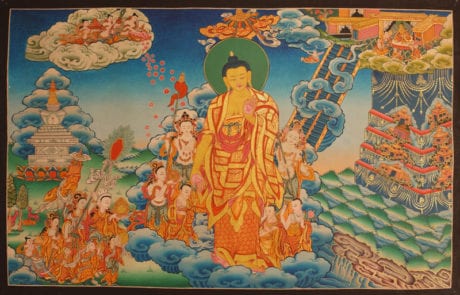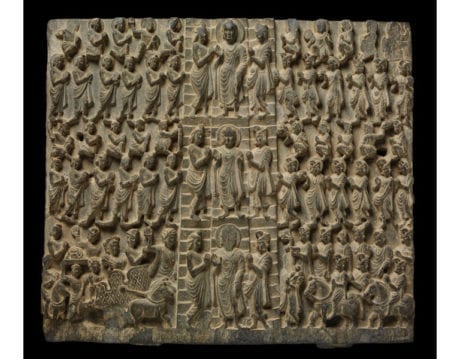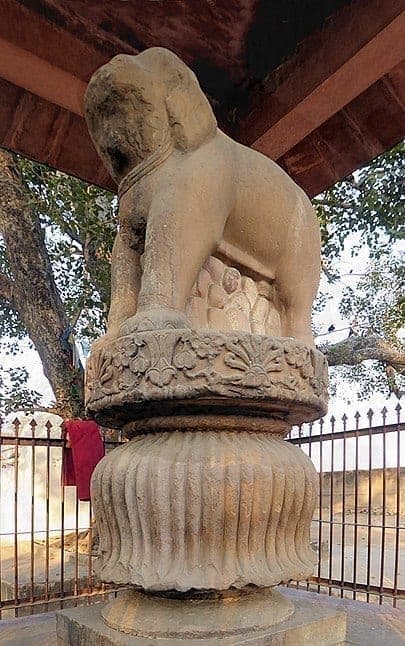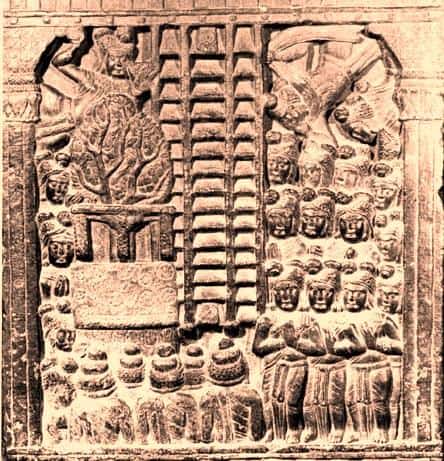Lha Bab Düchen in Tibetan translates as, ‘The Festival of the Descent from Heaven.’ We celebrate this great event on the 22nd day of the ninth month of the Tibetan lunar calendar, marking the descent of the Buddha from the Trāyastriṃśa Heaven (the Heaven belonging to the thirty-three deities).
According to biographies of the Buddha, his mother, Māyā, died seven days after the Buddha’s birth and was reborn in Tuṣita heaven. In his 41st year, the Buddha resolved to repay her kindness and to teach the Abhidharma to her and to the gods. From Tuṣita, Māyā traveled to Trāyastriṃśa Heaven and received these teachings—thereby becoming liberated from cyclic existence.
The Buddha taught the Abhidharma for a month and then indicated the time for his return to the earthly realm. Alerted by the Buddha’s descent, a huge assembly gathered including the kings and people of the eight great Indian kingdoms.
As the Buddha prepared to descend, a bejeweled flight of stairs appeared, and the Buddha glided down this staircase. On his right, a golden stairway appeared, and the god Brahma, holding a white chauri, or fly whisk, returned to earth on this. And on the Buddha’s left, the god Indra descended a flight of silver stairs, holding a jeweled umbrella. They were accompanied by a large crowd of gods.
Lha Bab Düchen: Illuminating the Worlds
As the Buddha descended, he looked upwards and illuminated all the worlds from the human world up to the highest heavenly realm. And then he gazed in all directions of the universe –turning it clear and unobstructed. Finally, when he looked downwards, this brilliance continued down to the hell realms.
At that very instant beings living in these three realms could all see each other. The human beings saw the devas, the devas saw the humans, the humans and the devas saw the hell beings, and the hell beings saw the devas and humans. Every one of these beings could also see the Buddha, in all his glory.

The 5th-century master Buddhaghosa, in his Dhammapada commentary, wrote, “On this day when the beings of all realms saw each other, there was not one who did not want to be the Buddha.” Later, a Burmese text, the Pathamasambodhi adds a teaching, “At that time, of all the devas, humans and beasts, even down to the tiniest red or black ant, who saw the Buddha, there was not one among them who did not desire Buddhahood.”
Descent of the Buddha
The beautiful schist relief panel below, probably carved in the 2-3rd c. CE in modern Pakistan belongs to the collections of the Victoria and Albert Museum in London. It depicts in great detail the descent of the Buddha from the Trāyastriṃśa Heaven (Heaven of the Thirty-Three) the second of the desire realm heavens.

This relief depicts the Buddha three times as he descends the central stairway. Each image shows him attended by the god Indra to the right (wearing a turban) and Brahma (with matted dreadlocks piled high) on the left. Both descend their own stairways, facing toward the Buddha and respectfully joining hands in homage.
A large crowd of celestial and human devotees surrounds the staircases. In the upper four rows, we see divine devotees, kneeling and standing, but identified by their halos. In the lower levels, we see human figures, some on horseback and wearing rich attire. We even see a horse-drawn chariot, carrying a turbaned man and a woman, and a child. Some art historians suggest that this figure might represent King Udayana of Kauśāmbī. This king, who was said to be present at the descent, was famous for having been so desolate during the Buddha’s stay in heaven that he commissioned the first image of the Buddha (a sandalwood sculpture).
A Place of Pilgrimage
The Buddha descended to earth at Sāṃkāśya (modern Sankisa or Sankass in Uttar Pradesh). This place became a major pilgrimage site and is one of the eight great pilgrimage places in India.
Moreover, the Chinese pilgrim Faxian tells us that the descent place was considered to be one of the defining fixed sites of a buddha’s career. Faxian described this:
Four places are always determined in advance: where the Buddhas shall attain Buddhahood; where they shall begin to preach; where they shall expound the law and refute heretics; and where they shall descend from the Heaven after having preached to their mothers. Other places are chosen according to circumstances.

When the 3rd century CE Indian emperor Aśoka came to the site as a pilgrim hundreds of years later he ordered men to dig into the earth around the remains in order to discover their depth. Although they reached the level of water, they could not find the stairs’ end. Amazed, Aśoka then built a temple over the remaining stairs and placed a standing image of the Buddha above the middle flight. Behind this temple, he erected a great pillar topped with an elephant capital. And today we can still see the remains of this pillar at the site.
The Eight Great Sites
These sites marked the place of eight great events in the Buddha’s life and teaching career.
- Lumbinī (Birth)
- Bodh Gayā (Awakening)
- Sārnāth (First turning of the Dharma wheel)
- Śrāvastī (Sāvatthī) (Miracle of fire and water performed)
- Sāṃkāśya (Great descent from heaven)
- Rājagṛha (Taming of the wild elephant)
- Vaiśālī (Gift of honey by a monkey and the turning of the third wheel of Dharma)
- Kuśinagara (Mahāparinirvāṇa)
Multiplying Merit on Lha Bab Düchen
During Lha Bab Düchen, one of the four great festivals of the Tibetan Buddhist calendar, the effects of positive or negative actions are multiplied ten million times. Therefore, we engage in virtuous activities such as lighting butter lamps, giving alms to the needy, circumambulating sacred sites, making aspiration prayers, and engaging in meditation practices on this day.
To you, the King of Śākyas, we pay homage!
On this day, you may also wish to recall the kindness of the Buddha by practicing the Treasury of Blessings sādhana, composed by Mipham Rinpoche. You can also read Ārya Nāgārjuna’s Praise of the Twelve Deeds of the Buddha.



